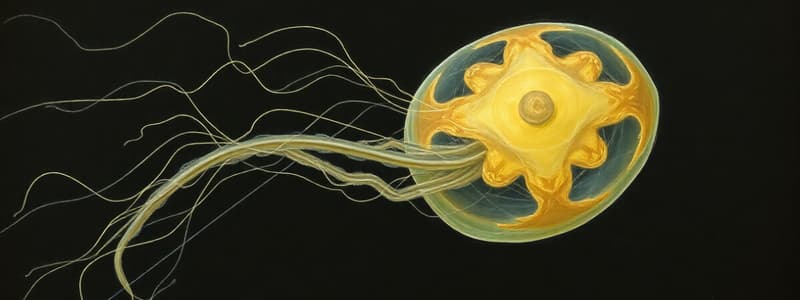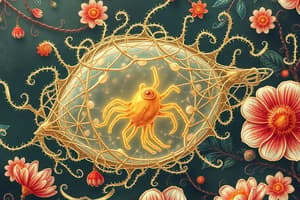Podcast
Questions and Answers
What are the two primary forms of parasites?
What are the two primary forms of parasites?
- Bacteria and viruses
- Single-celled protozoa and multicellular metazoa (correct)
- Fungi and protozoa
- Helminths and nematodes
Which group of protozoa does Entamoeba histolytica belong to?
Which group of protozoa does Entamoeba histolytica belong to?
- Sporozoa
- Ciliata
- Sarcodina (correct)
- Mastigophora
In which host does a parasite achieve sexual maturity and reproduction?
In which host does a parasite achieve sexual maturity and reproduction?
- Reservoir host
- Definitive host (correct)
- Intermediate host
- Vector host
What is the life cycle stage of Entamoeba histolytica that is motile?
What is the life cycle stage of Entamoeba histolytica that is motile?
Which condition is primarily caused by Entamoeba histolytica?
Which condition is primarily caused by Entamoeba histolytica?
Which of the following is a characteristic symptom of acute intestinal amebiasis?
Which of the following is a characteristic symptom of acute intestinal amebiasis?
What do reservoirs or carrier hosts do?
What do reservoirs or carrier hosts do?
Which of the following is NOT a subgroup of metazoa?
Which of the following is NOT a subgroup of metazoa?
What is a characteristic feature of the trophozoite stage of Giardia lamblia?
What is a characteristic feature of the trophozoite stage of Giardia lamblia?
What typical symptom accompanies the watery diarrhea caused by Giardia lamblia?
What typical symptom accompanies the watery diarrhea caused by Giardia lamblia?
Which statement accurately describes Trichomonas vaginalis?
Which statement accurately describes Trichomonas vaginalis?
Which of the following is a common epidemiological characteristic of malaria?
Which of the following is a common epidemiological characteristic of malaria?
What is the primary method of transmission for the parasites causing malaria?
What is the primary method of transmission for the parasites causing malaria?
Which species are considered the primary causes of malaria?
Which species are considered the primary causes of malaria?
What percentage of infected men experience symptoms of urethritis due to Trichomonas vaginalis?
What percentage of infected men experience symptoms of urethritis due to Trichomonas vaginalis?
During which phase of the Plasmodium life cycle does sporogony occur?
During which phase of the Plasmodium life cycle does sporogony occur?
What type of organisms are nematodes classified as?
What type of organisms are nematodes classified as?
Which of the following nematodes are transmitted by ingestion of eggs?
Which of the following nematodes are transmitted by ingestion of eggs?
Which nematode is specifically known to also exist in soil besides the human body?
Which nematode is specifically known to also exist in soil besides the human body?
What anatomical feature is typically found in male nematodes?
What anatomical feature is typically found in male nematodes?
What are the motile embryos produced by filarial worms called?
What are the motile embryos produced by filarial worms called?
Which mechanism transmits important tissue nematodes like Wuchereria and Onchocerca?
Which mechanism transmits important tissue nematodes like Wuchereria and Onchocerca?
What type of nematode is Dracunculus, also known as the guinea worm?
What type of nematode is Dracunculus, also known as the guinea worm?
Which of the following is NOT classified as a medically important cestode?
Which of the following is NOT classified as a medically important cestode?
What disease is caused by the protozoan Toxoplasma gondii?
What disease is caused by the protozoan Toxoplasma gondii?
What is the primary vector for Trypanosoma cruzi, the causative agent of Chagas' disease?
What is the primary vector for Trypanosoma cruzi, the causative agent of Chagas' disease?
Which type of leishmaniasis is caused by infection with the Leishmania species?
Which type of leishmaniasis is caused by infection with the Leishmania species?
The life cycle of Trypanosoma gambiense involves which insect as a vector?
The life cycle of Trypanosoma gambiense involves which insect as a vector?
What are the main structural components of tapeworms?
What are the main structural components of tapeworms?
What is the impact of Schistosoma species in terms of human morbidity?
What is the impact of Schistosoma species in terms of human morbidity?
What type of disease does Leishmania cause?
What type of disease does Leishmania cause?
Which of the following is NOT a form of leishmaniasis?
Which of the following is NOT a form of leishmaniasis?
Flashcards
Definitive host
Definitive host
The host where the parasite reaches maturity and reproduces.
Intermediate host
Intermediate host
The host where the parasite undergoes essential developmental stages.
Reservoir host
Reservoir host
A host that carries the parasite, serving as a source of infection for other hosts, but doesn't show symptoms.
Vector
Vector
Signup and view all the flashcards
What are Protozoa?
What are Protozoa?
Signup and view all the flashcards
Entamoeba histolytica
Entamoeba histolytica
Signup and view all the flashcards
Trophozoite (Entamoeba histolytica)
Trophozoite (Entamoeba histolytica)
Signup and view all the flashcards
Cyst (Entamoeba histolytica)
Cyst (Entamoeba histolytica)
Signup and view all the flashcards
What is Giardia lamblia?
What is Giardia lamblia?
Signup and view all the flashcards
Giardiasis
Giardiasis
Signup and view all the flashcards
Trophozoite (Giardia lamblia)
Trophozoite (Giardia lamblia)
Signup and view all the flashcards
Cyst (Giardia lamblia)
Cyst (Giardia lamblia)
Signup and view all the flashcards
Trichomonas vaginalis
Trichomonas vaginalis
Signup and view all the flashcards
Trichomoniasis
Trichomoniasis
Signup and view all the flashcards
Plasmodium
Plasmodium
Signup and view all the flashcards
Malaria
Malaria
Signup and view all the flashcards
What is Toxoplasmosis?
What is Toxoplasmosis?
Signup and view all the flashcards
How is Toxoplasmosis transmitted?
How is Toxoplasmosis transmitted?
Signup and view all the flashcards
What is Chagas' disease?
What is Chagas' disease?
Signup and view all the flashcards
What is Sleeping Sickness?
What is Sleeping Sickness?
Signup and view all the flashcards
What is Leishmaniasis?
What is Leishmaniasis?
Signup and view all the flashcards
What is the cause of Leishmaniasis?
What is the cause of Leishmaniasis?
Signup and view all the flashcards
What are Trematodes and Cestodes?
What are Trematodes and Cestodes?
Signup and view all the flashcards
How do tapeworms infect humans?
How do tapeworms infect humans?
Signup and view all the flashcards
What are Nematodes?
What are Nematodes?
Signup and view all the flashcards
What is a Cuticle?
What is a Cuticle?
Signup and view all the flashcards
What are the sexes of Nematodes?
What are the sexes of Nematodes?
Signup and view all the flashcards
What are Intestinal Nematodes?
What are Intestinal Nematodes?
Signup and view all the flashcards
What are Tissue Nematodes?
What are Tissue Nematodes?
Signup and view all the flashcards
What are Microfilariae?
What are Microfilariae?
Signup and view all the flashcards
How are Filarial Worms Transmitted?
How are Filarial Worms Transmitted?
Signup and view all the flashcards
How is Dracunculus Transmitted?
How is Dracunculus Transmitted?
Signup and view all the flashcards
Study Notes
Medically Important Parasites
- Parasites can be unicellular (protozoa) or multicellular (helminths, or worms).
- Protozoa are categorized into Sarcodina (amoebas), Sporozoa (sporozoans), Mastigophora (flagellates), and Ciliata (ciliates). Examples include Entamoeba histolytica and Giardia lamblia.
- Metazoa are subdivided into two phyla: Platyhelminthes (flatworms) and Nemathelminthes (roundworms). Cestoda (tapeworms) and Trematoda (flukes) are examples of flatworms.
Protozoa
- Entamoeba histolytica causes amebic dysentery and liver abscess.
- The life cycle has two stages: trophozoite (motile) and cyst (nonmotile).
- Transmission is often through contaminated food or water.
- Protozoa are often transmitted through food and water contaminated with fecal matter.
Intestinal & Urogenital Protozoa
- Entamoeba histolytica is a major cause of intestinal and urogenital infections.
- It causes amebiasis, potentially leading to dysentery.
- Giardia lamblia, another important parasite, causes giardiasis, characterized by watery diarrhea.
Giardia lamblia
- Its life cycle involves two stages: trophozoite and cyst.
- The trophozoite is pear-shaped with two nuclei, four pairs of flagella, and a suction disk.
- Symptoms include watery, foul-smelling diarrhea, nausea, anorexia, flatulence, and abdominal cramps.
Trichomonas vaginalis
- Causes trichomoniasis, a sexually transmitted infection.
- It's a pear-shaped organism, with a central nucleus and four anterior flagella, and undulating membrane that extends about two-thirds of its length.
- Exists only as a trophozoite (no cyst stage).
- Symptoms in women include a watery, foul-smelling, greenish vaginal discharge accompanied by itching and burning.
- In men, the infection is usually asymptomatic, but about 10% have urethritis.
Malaria (Plasmodium spp.)
- Caused by four plasmodia: Plasmodium vivax, Plasmodium ovale, Plasmodium malariae, and Plasmodium falciparum.
- P. vivax and P. falciparum are the most common types.
- Vector and definitive host is the female Anopheles mosquito.
- The life cycle has two phases: sexual (in mosquito) and asexual (in humans). Transmission is from the mosquito bite.
- Symptoms can range from fever to severe complications.
Toxoplasmosis (Toxoplasma gondii)
- A zoonotic disease caused by the Coccidian protozoan Toxoplasma gondii.
- Transmitted through contaminated food\meat.
- Can be transmitted through the placenta, causing severe complications in pregnant women.
- Infections in healthy individuals are usually mild or asymptomatic, but infections in immunocompromised individuals can be serious.
Chagas Disease (Trypanosoma cruzi)
- Caused by T. cruzi parasite.
- Transmitted by the reduviid bug (Triatoma).
- The life cycle involves the insect as the vector.
- Symptoms can range from acute to chronic; chronic Chagas disease is often associated with severe cardiac complications.
African Trypanosomiasis/Sleeping Sickness (Trypanosoma spp.)
- Caused by T. gambiense and T. rhodesiense parasites.
- Transmitted by the tsetse fly.
- Symptoms range from fever and headache to severely debilitating symptoms associated with brain and organ involvement.
Leishmaniasis (Leishmania spp.)
- Caused by the unicellular, flagellate, intracellular protozoa in the genus Leishmania.
- Transmitted through sandfly bites.
- There are different forms (visceral, cutaneous, and mucocutaneous.)
- Different geographical types of leishmaniasis are associated with infection in dogs in those areas.
Trematodes (Flatworms)
- Trematoda (flukes) and Cestoda (tapeworms) are two groups of the platyhelminths.
- Schistosoma (blood flukes), Paragonimus (lung fluke), and Clonorchis (liver fluke) are important trematodes, often having many people infected, leading to morbidity and mortality.
- Transmission is frequently through contact with contaminated water.
Cestodes (Tapeworms)
- Consist of a head (scolex) and segmented body (proglottids).
- Humans usually acquire tapeworm infections by consuming undercooked meat.
- Important cestodes include Taenia solium, Taenia saginata, Diphyllobothrium latum, and Echinococcus granulosus.
Nematodes (Roundworms)
- Roundworms with a cylindrical body, mouth, and anus and are characterized by their highly resistant, non-cellular outer coating.
- Intestinal nematodes include Enterobius (pinworm), Trichuris (whipworm), Ascaris (giant roundworm), Necator and Ancylostoma (hookworms), Strongyloides (small, roundworm) and Trichinella.
- Important tissue nematodes are Wuchereria, Onchocerca, and Loa.
- Transmission of these roundworms commonly occurs via ingested contaminated food or water.
Important Notes
- Parasite transmission often involves both a human host and an intermediate vector (like an insect)
- Transmission to humans can often occur through exposure to contaminated food, water, or the environment.
Studying That Suits You
Use AI to generate personalized quizzes and flashcards to suit your learning preferences.




